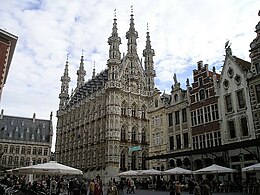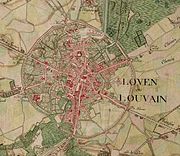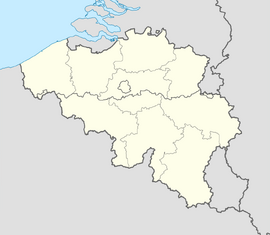| Main | Births etc |
|---|
| Leuven | ||||||
|---|---|---|---|---|---|---|

| ||||||
| ||||||
| Location of Leuven in Flemish Brabant | ||||||
| Sovereign state | ||||||
| Region | ||||||
| Community | ||||||
| Province | Template:BE-PROV-VB | |||||
| Arrondissement | Leuven | |||||
| Coordinates | Coordinates: | |||||
| Area | 56.63 km² | |||||
| Population – Males – Females – Density |
95,463 (1 January 2010) 49.66% 50.34% 1,686 inhab./km² | |||||
| Age distribution 0–19 years 20–64 years 65+ years |
(01/01/2006) 19.59% 63.45% 16.95% | |||||
| Foreigners | 9.43% (01/07/2005) | |||||
| Unemployment rate | 8.67% (1 January 2006) | |||||
| Mean annual income | €15,183/pers. (2003) | |||||
| Mayor | Louis Tobback (SP.A) | |||||
| Governing party/ies | SP.A-Vl.Pro, CD&V-N-VA | |||||
| Postal codes | 3000, 3001, 3010, 3012, 3018 | |||||
| Area codes | 016 | |||||
| Website | www.leuven.be | |||||
Leuven (Dutch, pronounced [ˈløːvə(n)] ( listen); French: Louvain, pronounced [luvɛ̃], often used in English, German: Löwen) is the capital of the province of Flemish Brabant in the Flemish Region, Belgium. It is located about 30 kilometers east of Brussels, close to other neighbouring towns such as Mechelen, Aarschot, Tienen, and Wavre.The township itself comprises the historical city of Leuven and the former municipalities of Heverlee, Kessel-Lo, a part of Korbeek-Lo, Wilsele and Wijgmaal.
It is home to Anheuser-Busch InBev, the world's largest brewer group and one of the top five largest consumer goods companies in the world; and to the Katholieke Universiteit Leuven, the largest and oldest university of the Low Countries and the oldest Catholic university still in existence.
History[]

Leuven on the Ferraris map (around 1775)

View over Leuven, late 19th century.

Destruction of the university library, 1914.
The earliest mention of Leuven ("Loven") is from 891 when a Viking army was defeated by the Frankish king Arnulf of Carinthia (see: Battle of Leuven). According to the city legend, its red-white-red colours depict the blood-stained shores of the river Dijle after this battle.
Situated at this river and nearby the stronghold of the Dukes of Brabant, Leuven became the most important centre of trade in the duchy between the 11th and the 14th century. A token of its former importance as a centre of cloth manufacture, is nicely reflected in the typical Leuven linen cloth, known in late 14-15th century texts as lewyn (other spellings: Leuwyn, Levyne, Lewan(e), Lovanium, Louvain).[1]
In the 15th century a new golden era began with the founding of the by now largest and oldest university in the Low Countries, the Catholic University of Leuven, in 1425.
In the 18th century Leuven became even more important as a result of the flourishing of the brewery now named AB InBev, and whose flagship beer, Stella Artois, is brewed in Leuven.
In the 20th century, both world wars inflicted major damage to the city. Upon German entry in World War I, the town was heavily damaged due to German Schrecklichkeit policy. The Germans shot the burgomaster, university rector and all the city's police officers.[2] The university library was deliberately destroyed by the German army on August 25, 1914, using petrol and incendiary pastilles. Hundreds of thousands of irreplaceable volumes and Gothic and Renaissance manuscripts were lost. [3] [4] The world was outraged over this and the library was completely rebuilt after World War I with American charity funds and German war indemnities. After World War II, the burnt down building had to be restored again. It still stands as a symbol of the wars and of Allied solidarity.
Economy[]
Given the presence of the KULeuven, an important European institution for academic research and education, much of the local economy is concentrated on spin-offs from academic research. There are several biotech and ICT companies; Gasthuisberg, the academic hospital and research center and a large number of private service providers in the medical and legal field.
Being the capital of the region of Flemish-Brabant means that there are many governmental institutions located in Leuven as well as the regional headquarters of transport corporations such as De Lijn. As the largest and one of the oldest Flemish cities in the immediate vicinity of Leuven, with a large palate of cafés, restaurants, cultural institutions and shopping neighbourhoods, the city also attracts people from nearby cities and villages.
Leuven is also the worldwide headquarters of Anheuser-Busch InBev, the largest beer company on the planet. In fact, InBev's Stella Artois brewery and main offices dominate the entire north-eastern part of the town, between the railway station and the canal to Mechelen.
Population[]
Student population[]
Nowadays Leuven is a real "student city", as during the academic year most citizens in its centre are students.
Leuven sports one of the liveliest bar scenes in Belgium. Besides boasting the "longest bar" in Belgium, the Old Market, dozens of bars and cafés crammed into a central square in Leuven, it's also the proud home city of Belgium's smallest bar, Onder den Toog in the Noormannenstraat.
The Katholieke Universiteit Leuven (KU Leuven; University of Leuven) is the oldest Catholic university still in existence in the world and the biggest university in Belgium.
There are also a number of hogescholen (Vocational university, literally translated: "high schools") such as the Katholieke Hogeschool Leuven (KHLeuven; the Catholic High School Leuven), as well as a university college: Groep T (Group T).
Politics[]
Mayor[]
The mayor of Leuven is currently Louis Tobback, a socialist politician prominent on the national level, formerly minister of internal affairs and leader of the socialist faction in the lower chamber of the Belgian parliament, among other positions held.
Culture[]
One of Belgium's finest conservatories is based in Leuven: the Lemmens Institute, which is described as "Faculty of Music, Performing Arts and Education". It is known for its Music Therapy Education and its Wordart-Drama Education.
Leuven is well known for its summer rock festival Marktrock. The main football club of the municipality is Oud-Heverlee Leuven, the successor of K. Stade Leuven. Leuven also has some orchestras, like the famous Arenberg Orchestra (Dutch).
Sights[]

The Town Hall.
Fonske.
- The Town Hall, built by Sulpitius van Vorst, Jan II Keldermans, and, after both of them died, Matheus de Layens between 1439 and 1463 in a Brabantian late-Gothic style. The reception hall dates from 1750.
- The St. Peter's Church (1425–1500) was finished by Jan Keldermans and Matheus de Layens. During the Second World War the church was damaged; during the restoration a Romanesque crypt from the 11th century was found. In the church itself there are several paintings from the 17th and 18th centuries (amongst others Dirk Bouts famous painting of the last supper) and the grave of Duke Henry I of Brabant. The 50 meter high tower—which was meant to be 169 meters but was never completed—is home to a carillon. The tower was included in UNESCO's list of Belfries of Belgium and France in 1999.
- Saint-Anthony's Chapel, Pater Damiaanplein, from the 17th to the 20th centuries, contains the tomb of Father Damien, the "leper priest" of Molokai, beatified by Pope John Paul II. The Catholic priest's remains were returned in Belgium with great fanfare in 1936 after having been originally buried on the Hawaiian Island of Molokai where he had served the outcast lepers and died.
- The Linen-hall in an early-Gothic style, with baroque addition, is today the University Hall.
- The Church of Saint Michael was built in the typical Jesuit Baroque Style.
- The Church of Saint Quinten incorporates remains of a Romanesque church built in the 13th century.
- The University Library on the Ladeuzeplein was built by the American architect Whitney Warren. It was a gift from the American people to Leuven after World War I during which the Germans burned down the original library, causing much outroar in the USA. The tower houses one of the largest carillons in the world.
- Totem is a statue at the centre of the Ladeuzeplein; it is a work of the Belgian artist Jan Fabre. On a 23 meters high needle a giant jewel beetle shines, against the clouds pricked compared with the university library.
- There is a ducal castle dating from the 12th century on the Keizersberg ("Emperor's Mountain") which was demolished in the 17th Century. Today there is a neo-Romanesque Abbey where the castle once stood.
- The Large Beguinage is one of the world's best remaining examples of its architectural type. It was recognized by UNESCO as a World Heritage Site in 1998.
- There are several other smaller churches and chapels around town.
- "Fonske" is a statue near the centre of town. Its full name is Fons Sapientiae, Latin for "fountain of wisdom". The statue represents a university student who, while reading a book, lets wisdom flow into his head as liquid from a glass. Just like Manneken Pis in Brussels, Fonske is from time to time dressed in costumes appropriate for the occasion.
- Lerkeveld: A famous Jesuit abbey, headquarters of the Jesuits in Belgium.
- Irish College of Louvain/Leuven in located in the city on Pater Damiaanplein. The Leuven Institute for Ireland in Europe is located on the premises.
Famous inhabitants[]
Born in Leuven[]
- Most Dukes of Brabant in the 12th and 13th century
- Maria of Brabant, queen consort of France (1256–1321)
- Martin Margiela, fashion designer (b. 1957)
- Quentin Matsys, painter (1466–1530)
- Petrus van der Aa, jurist (1530–1594)
- Adriaan van Roomen, mathematician (1561–1615)
- Charles de Bériot, violinist (1802–1870)
- Eugène Prévinaire, (1805–1877), second governor of the National Bank of Belgium
- Laurent-Guillaume de Koninck, palaeontologist and chemist (1809–1887)
- Jean Stas, analytical chemist (1813–1891)
- Arthur De Greef, pianist and composer (1862–1940)
- Christian de Duve, cytologist and biochemist, recipient of the 1974 Nobel Prize for Physiology or Medicine (b. 1917)
- Hortense Clews World War II Resistance worker and concentration camp survivor (b.1926)
- Arthur Berckmans, comics author (b. 1929)
- Mark Eyskens, politician and former Prime Minister of Belgium (b. 1933)
- Louis Tobback, politician and mayor (b. 1938)
- Emiel Puttemans, middle- and long-distance runner (b. 1947)
- Chris Miseur, painter (b. 1953)
- Daniël Theys, expressive artist and glassmaker (b. 1953)
- Peter Van Lancker, boat designer (b. 1952)
- Jaak Pijpen, media personality (b. 1952)
- Frank Vandenbroucke, politician (b. 1955)
- Bruno Bosteels, philosopher, known for English translations of Alain Badiou (b. 1967)
- Kim Gevaert, sprint athlete, Olympic silver medalist in 4×100 relay (b. 1978)
- Jonathan Vandenbroeck, singer-songwriter, better known as Milow (b. 1981)
- Dries Mertens, footballer (b. 1987)
Lived in Leuven[]
- Jean Baptiste Abbeloos, orientalist and rector of the University of Leuven (1836–1906)
- Adrian VI, pope and theologian (1459–1523)
- Michel Baius, theologian (1513–1589)
- Dirk Bouts, painter (c. 1410/20-1475)
- Eustace Chapuys, Imperial ambassador to England (1489–1556)
- Matheus de Layens, architect (d.1483)
- Koenraad Elst
- Desiderius Erasmus, humanist and theologian (1466–1536)
- Cornelius Jansen, father of Jansenism (1585–1638)
- Jean-Baptiste Janssens, philosophy teacher, Superior General of the Society of Jesus (1889–1964)
- Abdul Qadeer Khan, metallurgical engineer (b. 1935)
- Georges Lemaître, astronomer (1894–1966)
- Ron Lewis, basketball player (b. 1984)
- Justus Lipsius, philologist and humanist (1547–1606)
- Mícheál Ó Cléirigh, Irish chronicler (1590–1643)
- Jan Van der Roost, composer (b. 1956)
- Philip Verheyen, surgeon and rector of the University of Leuven (1648–1711)
- Andreas Vesalius, anatomist, physician (1514–1564)
- Gerardus Mercator, Flemish cartographer (1512-1594)
Sister cities[]
Leuven is twinned with:
's-Hertogenbosch, Netherlands
Kraków, Poland
 Lüdenscheid, Germany
Lüdenscheid, Germany Rennes, France
Rennes, France
Besides these sister cities, Leuven has friendly relations with:
Tainan, Republic of China
Stellenbosch, South Africa
Cristian, Romania
In pop culture[]
Leuven is mentioned in the song "Dirty Blue" by Woven Hand, a lyric that mentions "the bells of Leuven".
References[]
- "Louvain", chapter from George Wharton Edwards 1911 book, Some Old Flemish Towns. (Wikisource)
- ^ "Blaeu Atlas (UCLA Library – YRL Reference and Instructional Services)". Library.ucla.edu. 2003-04-02. http://www.library.ucla.edu/yrl/reference/maps/blaeu/germania-inferior-nt.htm#prima_brabantiae. Retrieved 2011-09-16.
- ^ "Fighting the Great War" by Michael S. Neiberg page 15 Harvard University Press, 2005
- ^ Kramer, Alan (2008). Dynamic Of Destruction, Culture and mass killing in the first world war. Penguin. ISBN 9781846140136.
- ^ Gibson, Craig (2008). "The culture of destruction in the First World War". Times Literary Supplement (January 30, 2008). Retrieved on 2008-02-18.
External links[]
- Official Leuven website
- Wijgmaal website
- Leuven at Wikitravel
- Drieduizend, Leuven Photoblog
- Leuven photo gallery
- Detailed map of Leuven (detailed map of Leuven by the KUL)
- Free map of Leuven (partial OpenStreetMap of Leuven)
| ||||||||||
| This page uses content from the English language Wikipedia. The original content was at Leuven. The list of authors can be seen in the page history. As with this Familypedia wiki, the content of Wikipedia is available under the Creative Commons License. |





